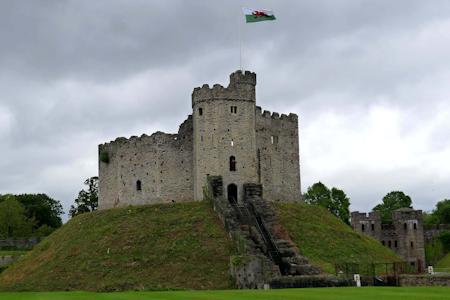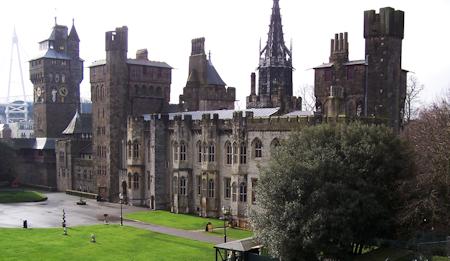
Cardiff Castle
The site of Cardiff Castle has been in use for almost 2,000 years. It started off as a Roman fort and then it became a castle in the medieval period before a Victorian renovation turned it into a luxurious Gothic revival mansion. Today you can see features from every part of its development.
A Roman fort was established here when the Romans first invaded South Wales in the middle of the 1st Century. It was rebuilt in the 3rd Century and abandoned at some point in the 4th or 5th Century.
The Norman castle was constructed shortly after William the Conqueror's invasion. There is some uncertainty as to who built it and when. It was possibly built by William the Conqueror in 1081 or perhaps by Robert Fitzhamon in 1091.
The Norman Castle
The early castle was a classic wooden motte-and-bailey design – albeit with a uniquely large motte. It was divided into two baileys and, as was typical when the Normans took over a Roman fort, the Roman walls were covered with large earth ramparts.
The castle stayed in Fitzhamon's hands until his death in 1106 at the Battle of Tinchebray. Henry I's eldest brother Robert Curthose, Duke of Normandy had attempted to take the English throne. The battle saw Robert decisively defeated and he spent the rest of his life in prison, first in Devizes Castle and then in Cardiff Castle. He died here in 1134.
The 12th Century was not uneventful for Cardiff Castle.
In 1122 Henry I gave the castle to Robert of Gloucester, his illegitimate son and husband to Fitzhamon's daughter. The castle passed down through the Fizhamon line until it eventually became the property of the powerful de Clare family and part of the Honour of Clare.
In the 12th Century the castle was converted to stone. A large polygonal shell keep was constructed on top of the motte. The inner bailey was also strengthened with stone walls on its southern and western sides.
Welsh Attacks
In 1158 Ifor Bach stormed the castle and kidnapped William Fitz Robert (Robert's son). A further Welsh raid in 1183 left the castle with some damage.
In 1184 the damage was repaired and town walls were constructed around the town of Cardiff. Cardiff's West Gate was also built around this time, between the castle and the river.
Richard de Clare carried out extensive building work in the late 13th Century. He built the Black Tower and completed the walls around the inner bailey.
Gilbert de Clare was killed at the Battle of Bannockburn in 1314. He was the last de Clare and Cardiff Castle passed to the Despenser family.
In 1404 Owain Glyndwr's rebellion arrived in Cardiff. His forces didn't take the castle, but the Black Tower and the southern gatehouse were badly damaged in the attack.
In 1423 Richard de Beauchamp, Earl of Warwick, married into the lordship. He carried out extensive building work at Cardiff. He restored the Black Tower and constructed a new tower beside it. The gatehouse was restored and the motte defences were strengthened.
Richard built the new state apartments in 1425. The range had a large octagonal tower and four smaller polygonal turrets facing the inner bailey. Richard also added a flower garden just south of the range.
Royal and Civil Wars
The turmoil brought about by the Wars of the Roses saw Cardiff Castle pass through a number of hands. Eventually it became the property of the Crown. In 1495 Henry VII revoked its Marcher lordship status and brought the whole area under English law. The castle was rented out to a number of tenants during this time and the Black Tower was in use as a prison.
During the English Civil War Cardiff was passed back and forth between the rival armies and even local militia. In 1645 it switched to the Parliamentarian side and successfully resisted Royalist attacks in 1646 and 1648.
After the war the castle wasn't slighted due to the threat of invasion from Scotland. Instead it was garrisoned by Parliamentary forces.
Marquess of Bute's Remodelling
By the late 18th Century it had come into the possession of John Stuart, 1st Marquess of Bute. He employed Capabilty Brown and Henry Holland to remodel the castle baileys. They made extensive changes. The wall between the inner and outer baileys was removed along with most of the medieval buildings in the outer bailey. They remodelled the range to make it more contemporary by adding new wings and removing many of the older features. The full extent of their changes was cut short by the death of the Marquess's son in 1794.
The next set of changes occurred when the third Marquess came of age in 1868. He had come to hate the existing castle and hired the renowned architect William Burges to remodel it in a Gothic Revivalist style. Between them they converted the castle's range to an exquisite Victorian country house. They added the Clock Tower, the Guest Tower, the Libary and the Banqueting Hall amongst many other additions and renovations.
Outside the remains of the Roman fort were uncovered and an archaeological investigation was conducted. New walls were added in a Roman style along with a Roman North Gate.
The renovations and archaeological digs continued in the 20th Century under the guiding hand of the fourth Marquess. The medieval masonry was restored along with the South Gate and barbican tower.
In 1947 John Crichton-Stuart, 5th Marquess of Bute, inherited Cardiff Castle and considerable death-duties. He gifted the castle and its lands to the City of Cardiff.
The Modern Castle
Today the castle is still run by Cardiff Council. They have it open to the public as a tourist attraction, heritage site and learning centre. In 2008 the council added an extensive new interpretation centre beside the South Gate.
The castle caters for school groups with its own dedicated Education Officer. A range of programmes are available from nursery school age right up to degree level.
Cardiff Castle hosts a number of cultural and heritage events from medieval jousting competitions, to Shakespeare evenings and lectures.
Parts of the castle are available for corporate hire, weddings and functions. The castle has an in-house team of people for weddings and civil partnership events.
For regular visitors facilities on offer include a cafe, gift shop, toilets (including accessible facilities), various guided tours and children's activities.
Disabled facilities at Cardiff Castle are unusually extensive for a medieval property. The interpretation centre, the grounds and some of the apartments have good wheelchair access. In addition, Touch Tours and audio guides in English and Welsh are available for the visually-impaired.
Status: Heritage Site / Visitor Attraction / Wedding Venue
Owner: Cardiff Council
Tel: +44 (0) 292 087 8100
Email: cardiffcastle@cardiff.gov.uk
Website: www.cardiffcastle.com
Opening Times: March to October Daily 9am-6pm / November to February 9am-5pm


The motte and keep at Cardiff Castle

The impressive Victorian state apartments